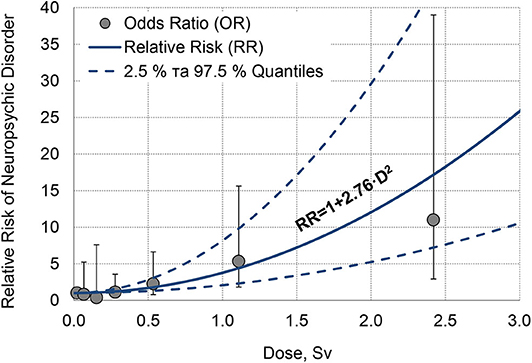- 1State Institution “National Research Center for Radiation Medicine of the National Academy of Medical Sciences of Ukraine”, Kyiv, Ukraine
- 2Dipartimento di Medicina Clinica e Sperimentale Section of Psychiatry, University of Pisa, Pisa, Italy
Goal: To explore the possible impact of ionizing radiation in the pathophysiology of neuropsychiatric disorders amongst clean-up workers of the Chornobyl catastrophe (liquidators).
Design, object, and methods: Retrospective-prospective study (1987–2015) of liquidators from the State Register of Ukraine (SRU) with radiation doses records and Clinical-Epidemiological Register (CER) of the State Institution ≪National Research Center for Radiation Medicine of the National Academy of Medical Sciences of Ukraine≫ (NRCRM). Moreover, cohort and cross-sectional studies of the randomized sample of liquidators from the CER (exposed group, 198 subjects) were examined. Internal control group included the liquidators irradiated in doses <50.0 mSv (42 persons). All subjects were assessed by a detailed clinical examination and a battery of standardized neuropsychiatric scales, psychometric, and neuropsychological tests. Descriptive and variation statistics, non-parametric criteria, regression-correlation analysis, survival analysis by Kaplan & Meier, and risk analysis were used.
Results: Exposed group vs. control group showed cognitive disorders in 99 (50.0%) vs. 20 (18.1%), (P = 0.04); affective disorders in 96 (48.3%) vs. 36 (32.7%) (P = 0.007), and stress-related disorders in 115 (58.4%) vs. 8 (7.3%) (P < 0.001). In the main group exposed to ≥50 mSv vs. internal control group (exposed to <50 mSv), affective disorders were present, respectively, in 89 (56.4%) vs. 7 (19.1%) (P < 0.001), and stress-related disorders in 98 (62.8%) vs. 17 (40.4%) (P = 0.009). Relative risks (RR) and 95% confidential intervals (95%CI) of Incidence of some neuropsychiatric disorders in liquidators of 1986–1987 related to internal control (doses <50 mSv) were as follows: organic psychosis (RR = 3.15; 95% CI: 2.6; 3.7); non-psychotic organic brain damage (RR = 1.99; 95% CI: 1.6; 2.5); acute (RR = 1.40, 95% CI: 1.3; 1.5), and chronic cerebrovascular disorders (RR = 1.23; 95% CI 1.0;1.5). Neuropsychiatric diseases show a strong, increasing, and approximately quadratic statistically significant (Pv < 0.001) relationship with individual dose, yielding an estimated excess relative risk ERR = 2.76 Sv−2 (95% CI 1.06–7.15).
Conclusions: Liquidators have an excess of cognitive, affective, and stress-related disorders. The risk of diseases rises with radiation dose. Radiation risks are revealed for organic psychoses, non-psychotic organic brain damage, acute and chronic cerebrovascular pathology.
Introduction
The Chornobyl disaster was a catastrophic nuclear accident that occurred on the 26th April 1986 at the No. 4 nuclear reactor in the Chornobyl Nuclear Power Plant (ChNPP), near the city of Pripyat in the north of Ukraine (110 km from Kyiv), and it was the most serious accident ever to occur in the nuclear power industry. According to the International Nuclear and Radiological Event Scale (INES) the Chornobyl catastrophe was the highest, the 7th, level “major accident,” resulting in widespread health and environmental effects requiring implementation of planned and extended countermeasures (1). To date, there have been two accidents of this kind: the Chornobyl catastrophe (2) and Fukushima Daiichi nuclear disaster, a series of events beginning on 11 March 2011 (3, 4). In any case, radiological impact on people and environment of the Chornobyl catastrophe is around 10 times higher than that following the Fukushima Daiichi accident.
According to the latest estimates (5), ~1.8 EBq 131I radioactivity was thrown out of the destroyed ChNPP Unit, significantly higher than that following the Fukushima disaster. The same is concerning external doses of exposure: in Chornobyl the averaged dose for clean-up workers (“liquidators,” 600,000 persons) is assessed to be around 100 mSv (2, 6); for evacuees (135,000 persons) 33 mSv, for strict control zone inhabitants (living in the territories with radioactivity deposition >555 kBq·m−2) 50 mSv, and for low exposed (5,000,000 persons) 10–20 mSv (2, 6). On the contrary, the highest doses for Fukushima rescue workers were assessed to be 10–50 mSv, for Fukushima population 1–10 mSv, for Japan 0.1–1 mSv per year (3). For comparison, worldwide annual exposure to natural radiation sources would generally be expected to be in the range 1–10 mSv, with 2.4 mSv being the present estimate of the central value (7).
There are very contradictive assessments of the Chornobyl catastrophe health effects. The International, UN-associated, organizations (International Atomic Energy Agency (IAEA), World Health Organization (WHO), and the United Nations Scientific Committee on the Effects of Atomic Radiation (UNSCEAR) recognized only 31 death cases directly related to the accident, 134 verified cases of Acute Radiation Sickness (ARS) and around 6,000 cases of thyroid cancer reported in children and adolescents who were exposed at the time of the accident. They came to the conclusion that there was no sufficient scientific evidence concerning any other cancer and non-cancer Chornobyl health effects, while cataracts, leukemia, and cardiovascular (including cerebrovascular and neurocognitive) diseases are considered to be at the frame of radiation-associated effects in liquidators. Although those most highly exposed individuals are at an increased risk for radiation-associated effects, the great majority of the population is not likely to experience severe health consequences as a result of radiation from the Chornobyl accident. Many other health problems have been noted in the victims/survivors that were not attributed to radiation exposure, but to psychological consequences only. Therefore, in general, the conclusions of those agencies are as follows: the ChNPP accident was a tragic event for its victims, and those most affected suffered major hardship. Some people who dealt with the emergency lost their lives. Although those exposed as children, and the emergency and recovery workers, are at increased risk of radiation-induced effects, the vast majority of the population should not be concerned by serious health consequences. For the most part, individuals were exposed to radiation levels comparable to or just a few times higher than annual levels of natural background, and future exposures continue to slowly diminish as the radionuclides decay. Although lives had been seriously disrupted by the Chornobyl accident, from a radiological point of view, positive prospects for the future health of most individuals should prevail (2, 6, 8–10).
The UN Chornobyl forum (2006) concluded about persistent mental health worsening of the Chornobyl accident survivors as a result of (1) stress-related disorders; (2) effects on the developing brain; (3) organic mental disorders in liquidators, and (4) suicides. The revealed excess of cardiovascular and cerebrovascular disorders in liquidators was recognized as needing further investigation (8, 9).
By contrast, at the same time, ecologically oriented publications (Green Peace-related, (11–14)) argued that a so-called “atomic lobby” underestimates the environmental and health effects of the Chornobyl catastrophe. Green Peace is positive about the dramatic excess of cancer and non-cancer morbidity and mortality of the Chornobyl victims due to radiation exposure (11–14). However, it is likely that the truth seems to be in the middle (15–17).
There are few well-designed systematic epidemiological studies of mental health following the Chornobyl catastrophe. There is a consensus about long-term mental health deterioration, mainly at subclinical levels, attributed to stress and other non-radiation factors in residents of radioactively contaminated territories (18, 19), and cleanup workers, such as depression, anxiety and posttraumatic stress disorder (PTSD), suicidal ideation or attempted, or completed suicides (20, 21), alcohol abuse, poorer perceptions regarding personal physical and mental health (22). However, all these studies had no dosimetric support, with the exception of self-report exposure estimation (22). Therefore, the assessment of the radiation risk analysis for neuropsychiatric disorders in Chornobyl liquidators was impossible, which is why the attribution of all of these disorders to stress alone has no scientific base.
Interestingly, similar data on long-term mental health deterioration were reported after the A-bombing in Hiroshima and Nagasaki, Japan, 1945 (23, 24), Three Mile Island crisis, USA, 1979 (25, 26), and the Fukushima Daiichi accident, Japan, 2011 (27, 28).
Although a considerable worsening of mental health in the Chornobyl catastrophe survivors has been documented, however, the role of ionizing radiation in mental health deterioration is still unclear. Therefore, the purpose of our study was to assess the possible role of ionizing radiation in the pathophysiology of neuropsychiatric disorders amongst cleanup workers of the Chornobyl catastrophe (liquidators).
Design, Object, and Methods
Study Participants
We combined two sets of information:
(1) Follow-up data collected between 1987 and 2015 from the State Register of Ukraine (SRU) with doses of exposure records involving 68,145 liquidators, and from the Clinical-Epidemiological Register (CER) of the State Institution ≪National Research Center for Radiation Medicine of the National Academy of Medical Sciences of Ukraine≫ (NRCRM) including 3,548 persons. Two diagnostic criteria for nervous and mental/behavioral disorders were used, according to the 9th and 10th editions of the WHO International Classification of Diseases (ICD-9 and ICD-10). Clinical neurological and psychiatric diagnosis for the registers SRU and CER were provided by certified neurologists and psychiatrists according to the current ICD diagnostic criteria at the time of examination. Further, harmonization between ICD-9 and ICD-10 diagnosis of neuropsychiatric disorders were done according to elaborated in NRCRM converting tables from ICD-9 toward ICD-10 neuropsychiatric disorders. The epidemiological methods, including risk-analysis, were used.
(2) Retrospective-prospective (1987–2018) cohort and cross-sectional cohort data following neuropsychiatric verification with the external and internal control groups. In the Department of Radiation Psychoneurology of the Institute for Clinical Radiology (ICR) of NRCRM, the randomized sample of the Chornobyl clean-up workers from the CER of the NRCRM (main group 198 persons) was examined, together with 43 individuals evacuated from the Chornobyl exclusion zone. These subjects have been under prospective medical surveillance across their lifespan during the post-accidental years (1987–2018). Their neuropsychiatric diagnoses have been verified as described below.
The inclusion criteria in the main group were as follows: (1) availability in the CER of NRCRM; (2) participation in the works of clean-up of the consequences of the Chornobyl disaster in 1986–1987; (3) availability of the records of radiation doses; (4) men.
The patients' age of the main group at the moment of the last survey was between 39 and 87 years (mean ± SD: 60.0–8.5), and that at the time of the Chornobyl catastrophe was between 18 and 56 (mean ± SD: 32.1.1 ± 7.6). The doses of the external exposure of the examined clean-up workers were within the range of 0.6–5900.0 mSv with an average arithmetic dose (mean ± SD) of 456.0 ± 760.0 mSv. The dose of exposure distribution of the examinees is shown in Table 1. The clean-up worker subgroup irradiated at doses of 0.6–50.0 mSv (n = 42) was designated as the internal control group in relation to the main clean-up worker group. Such a decision to consider those exposed <50.0 mSv were based on: (1) current knowledge that there are no clear evidence-based data on deterministic (tissue reactions) radiation effects at such an exposure, and (2) the similar social-psychological status/exposure to both irradiated <50.0 and ≥50.0 mSv persons for the control non-radiation confounding factors.
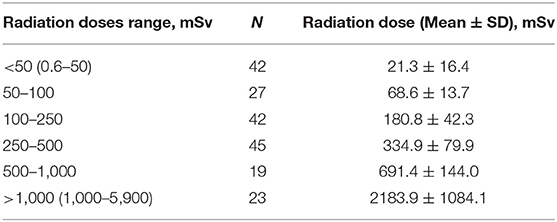
Table 1. Distribution of cleanup workers of the Chornobyl catastrophe by radiation doses of external exposure.
The comparison group (n = 110) was randomly formed from out- and inpatients of the Radiation Psychoneurology Department of ICR of NRCRM. Their age was between 45 and 70 years (mean ± SD: 53.6 ± 5.3) at the moment of the survey, and between 18 and 39 (mean ± SD:24.7–4.7) that at the moment of the Chornobyl disaster. The inclusion criteria in the comparison group were as follows: (1) no involvement in any radiation emergencies, nuclear tests, and therapeutic exposure; (2) absence of the extra irradiation in relation toward the background radioactivity with the exception of the medical diagnostic radiological procedures and air flights; (3) men; (4) age comparable to the main group. The exclusion criteria were as follows: (1) non-compliance with any of the inclusion criteria for the comparison group and (2) involvement in multicentre clinical trials.
Assessments for Cross-Sectional Study
The unified neuropsychiatric examination was carried out in accordance with the ICD-10 criteria (29), by using the methodical recommendations and clinical guidelines for diagnostics and verifying organic brain damage following radiation exposure as a result of the Chornobyl accident developed in the Department.
The following scales were used for diagnosis:
• the Expanded Disability Status Scale, EDSS (30);
• the Kurtzke Functional Systems Scores, KFS (31);
• the Brief Psychiatric Rating Scale (BPRS) (32, 33).
The following scales were employed for the qualitative and quantitative psychopathological assessment:
• the General Health Questionnaire (GHQ-28) to assessing somatoform symptoms, anxiety/insomnia, social dysfunction, and severe depression (34);
• the Zung Self-Rating Depression Scale (SDS) to measure depression (35);
• the Posttraumatic Stress Disorder (PTSD) questionnaires, the Impact of Events Scale (IES) (36) and Irritability, Depression, Anxiety (IDA) used to assess the agitation associated with PTSD (37);
• the Mini-Mental State Examination (MMSE) (38) for screening diagnosis of cognitive impairment.
• the Rey Auditory Verbal Learning Test (RAVLT) for evaluating memory functions (39).
• the Wechsler Adult Intelligence Scale (WAIS), adapted in 2012 by the IMATON (St. Petersburg) (40), to measure Intelligent Quotients (IQ). Premorbid (pre-emergency) intelligence quotients (pre-IQ) were calculated using the demographical-based regression equation by Gao et al. (41). The level of cognition was determined by the operational criteria of cognition based on the estimation of both the current IQ and the cognitive deficit after the Chornobyl catastrophe by the differences between premorbid (pre-emergency) and current IQ (42, 43).
Following the comprehensive clinical neuropsychiatric examination according to the Chapters G&F of the ICD-10 criteria, as well as the results of psychometric scales and tests just described, the expert neuropsychiatric conclusions were done and were further statistically estimated.
The study was conducted after obtaining written informed consent from each participant according to the Declaration of Helsinki (44).
Statistical Analyses
For statistical data analysis the descriptive statistics, regression-correlation analysis by Pearson & Spearman, Kaplan-Meier survival analysis, multiple linear and quadratic regressions, relative risk analysis and odds ratios, non-parametric criteria, as well as the tools for the graphical analysis, and the results presentation were used. The verification of the statistical hypothesis regarding the data correspondence to the normal distribution was carried out using the Kolmogorov-Smirnov criteria, adjusted by Lilliefors and Shapiro-Wilkes. Excel 8.0 spreadsheets were used to collect, store, and analyze the data. Statistical analysis was performed by Statistica 10.0 (StatSoft) (45), SPSS Statistics 17.0 (46) and EPICURE (HiroSoft http://www.hirosoft.com/) (47).
Risk analysis of following neuropsychiatric verification was performed using the well-known epidemiological statistical software EPICURE. Before this risk analysis, the data were cross-classified by the radiation dose (<0.05; 0.05–0.1; 0.1–0.2; 0.2–0.4; 0.4–0.8; 0.8–1.6; >1.6 Sv), age at exposure, that is, age at April 26, 1986 (<25; 25–40; >40 years), attained age, that is, the age at the moment of the neuropsychiatric pathology finding or at the censorship time (<30; 30–40; 40–50; 50–60; >60 years), as well as by the presence (was or was not) of post-traumatic stress disorder (PTSD). Therefore, 137 liquidators were included in the risk analysis, where 115 (83.9%) of them had verified neuropsychiatric disorders. Herewith, one of the modules of this epidemiological package PEANUTS, designed for data processing in the Cox Proportional Hazards Model for Censored Data, was used. The parameters of the linear and quadratic Cox proportional models of relative risk (RR) were estimated by EPICURE (47–49).
where λL, λQ are the neuropsychiatric morbidity rates in linear and quadratic risk models, respectively; λ0,L(t), λ0,Q(t), a basic risk at a time t that is not assessed; si, ai, and ei categorical variables determining the presence or absence of PTSD, as well as the age group and the age at exposure group in which a Chornobyl clean-up worker was; D is the exposure dose (Sv); αL,i, βL,i, γL,i, αQ,i, βQ,i, γQ,i, ρL, ρQ are parameters evaluated as a result of risk analysis. The sense of the parameters ρL and ρQ is the excess relative risk (ERR) in linear (A) and quadratic (B) models, respectively.
Results
According to the register's data (SRU), the incidence of organic, including symptomatic, mental disorders (organic psychosis) (ICD-9: 293.0–294.9: ICD-10: F00-F05; F06.0, F06.2) was 101.99 per 10,000 persons, and it showed the highest statistically significant (Pv < 0.001) relative risk (RR = 3.15; 95% CI: 2.6; 3.7) (Table 2).
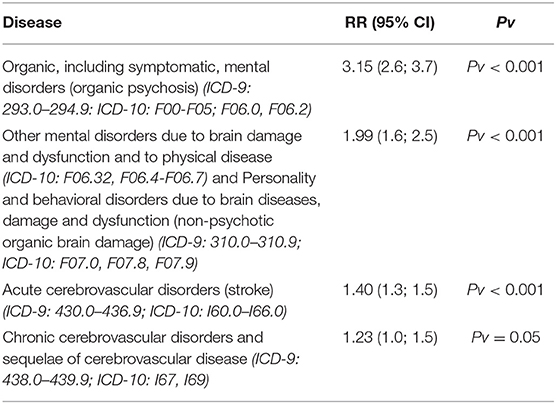
Table 2. Relative risks (RR) of Incidence of neuropsychiatric disorders in clean-up workers of 1986–1987 related to internal control (doses <50 mSv) according to the register's data.
Non-psychotic organic disorders (ICD-9: 310.0–310.9; ICD-10: ICD-10: F06.32, F06.4-F06.7F07.0, F07.8, F07.9) showed a RR=1.99 (Pv <0.001; 95% CI: 1.6; 2.5). These disorders included organic depressive, emotionally labile [asthenic], mild cognitive, anxiety, dissociative, as well as organic personality disorders.
Acute cerebrovascular disorders (strokes) had a RR = 1.40 (Pv < 0.001; 95% CI: 1.3; 1.5), and consequences/chronic cerebrovascular pathology, including cerebral atherosclerosis, hypertensive encephalopathy, and chronic cerebral ischemia, a RR = 1.23 (Pv = 0.05; 95% CI: 1.0; 1.5).
According to these previous findings, an expert assessment of neuropsychiatric disorders was carried out (Table 3). In comparison with the unexposed control group, liquidators showed significantly more cognitive disorders, in particular, mild cognitive impairment and dementia, and an increased percentage of affective disorders, mainly severe depression. The frequency of affective and stress disorders was significantly increased in clean-up workers exposed to doses ≥50 mSv, as compared to those exposed to lower doses, with a tendency toward a greater frequency of cognitive impairment (Table 4).
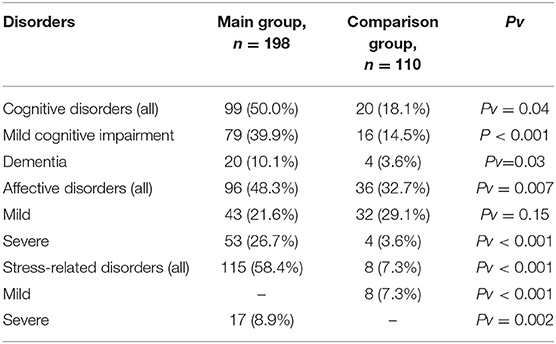
Table 3. Assessment of cognitive, affective, and stress-related disorders in the main group (clean-up workers) and the comparison group.
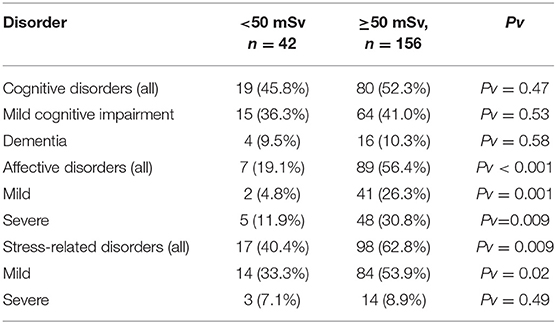
Table 4. Assessment of cognitive, affective, and stress-related disorders in clean-up workers exposed to radiation in doses <50 mSv (internal control) vs. those exposed to ≥50 mSv.
According to the survival analysis, we considered the time of the onset of any neuropsychiatric pathology after the Chornobyl accident measured in years as the event in which the pathology arose after the catastrophe. As shown in Figure 1, neuropsychiatric disorders in clean-up workers appeared much earlier, that is to say, between 3 and 5 years after the disaster (Log-Rank Test = 4.96, P = 0.000). By contrast, only 30 years later, these disorders occurred approximately at same rate both in the clean-up workers and the unexposed control group. In addition, in the clean-up workers who were also evacuated from the Chornobyl exclusion zone, neuropsychiatric disorders began to emerge significantly later than 7–10 years after the disaster than in those not evacuated (Log-Rank Test = −3.13, P = 0.002). During the first 15 post-accidental years, the dependence of the occurrence of neuropsychiatric disorders upon the irradiation dose was detected at doses >300 mSv. The onset of these conditions occurred quite early, almost immediately after the disaster; at doses of 50–300 mSv 2 years later, and at doses lower than 50 mSv after ten 10 years (χ2 = 8.74 P = 0.01), this dependence disappears.
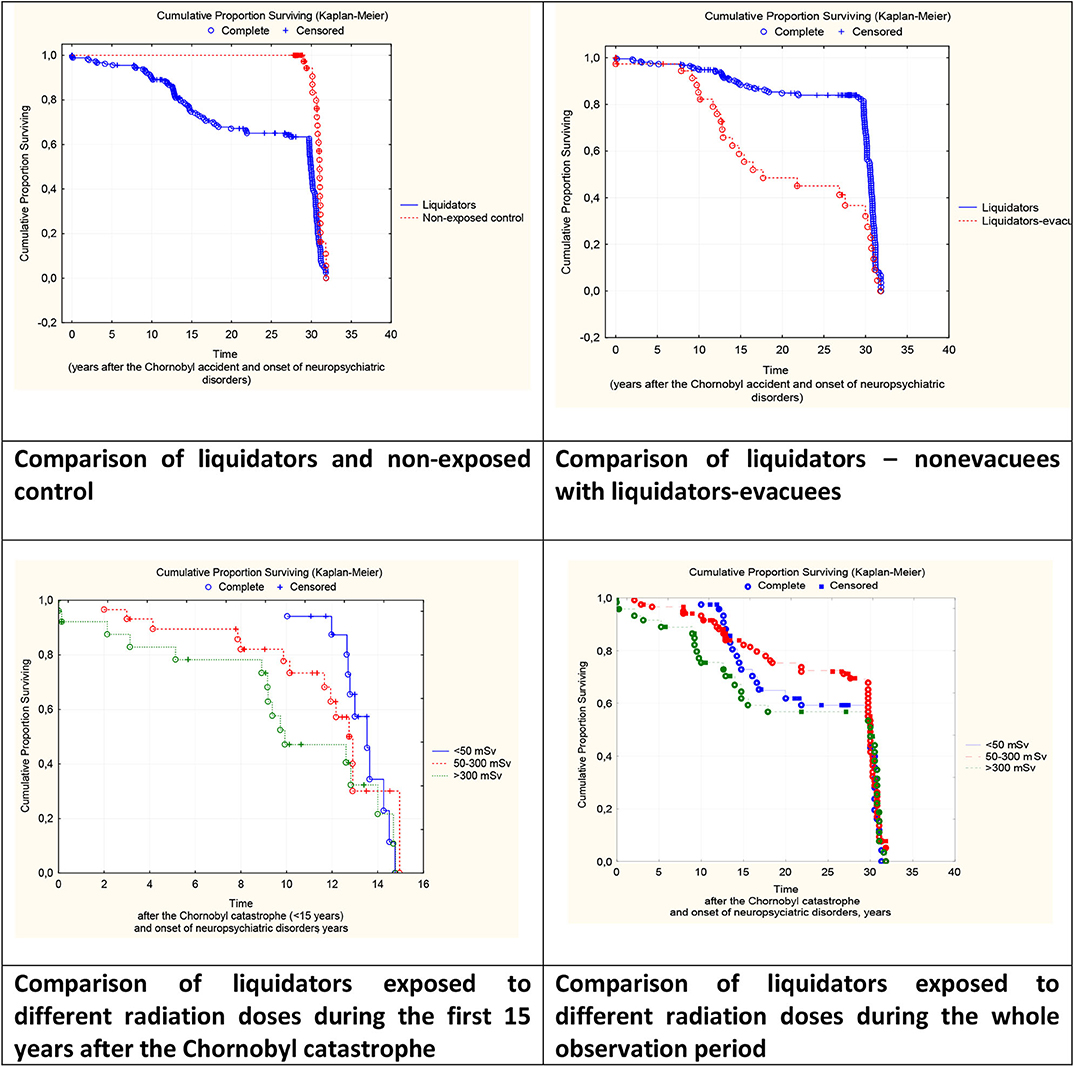
Figure 1. Survival curves (Kaplan & Meier) for neuropsychiatric pathology onset after the Chornobyl catastrophe.
Risk Analysis
Dose-response analysis for 137 liquidators was done with the help of PEANUTS module of EPICURE package. This module is used for analysis of ungroup censored survival data using partial likelihood methods for distribution-free hazard function, often called proportion hazards models or Cox proportional models (47–49). Odds ratio (OR) as well as parameters of the linear (A) and quadratic (B) model of relative risk were estimated.
The odds ratio for mental disorders and their 95% confidence interval, as well as the likelihood ratio test (LRT), were calculated for each group (Table 5). The overall risk of neuropsychiatric diseases statistically significant (Pv < 0.001) increases with the exposure dose. As seen in Table 5, the OR of neuropsychiatric diseases for persons with doses from 0.05 to 0.2 Sv is ever smaller than for the persons with dose <0.05 Sv (50 mSv) and for persons with doses from 0.2 to 0.4 Sv it is a bit higher, but the difference is not statistically significant. At the same time, for doses >0.4 Sv, the risk of neuropsychiatric diseases is 2–11 times larger compared with that at small doses (below 0.05 Sv), and such a difference is statistically significant. Also with high statistical significance (Pv < 0.001), the OR is on average 2.2 times larger for persons with post-traumatic stress disorder than for persons without it, and it is 3.5–11 times significantly larger (Pv < 0.001) for the persons who were older than 25 at the time of exposure than for the persons younger than 25. The overall risk of neuropsychiatric diseases statistically significantly decreases with the attained age (Pv < 0.001). This phenomena can be caused by a linear relation between attained age and time since exposure and just reflect the fact that the bulk of neuropsychiatric disorders in the Chornobyl clean-up workers realized during the first 15 years after the disaster (Figure 2).
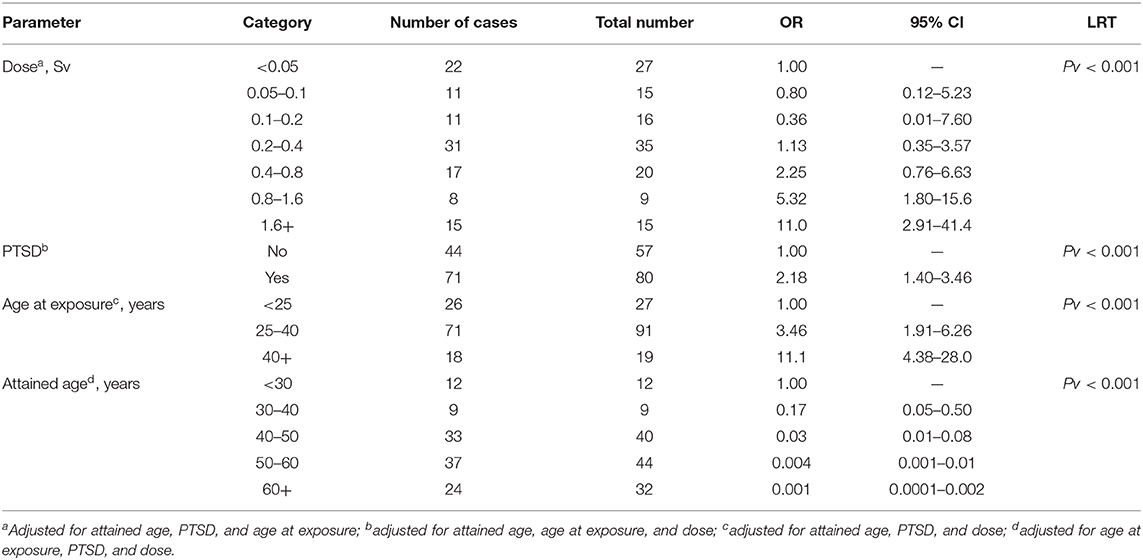
Table 5. Odds ratio (OR), 95% confidence interval (CI), and reliability probability based on probability function (LRT) for the different groups of the clean-up workers.
The estimation of the parameters in the dose-response linear model (A) yielded statistically significant (Pv < 0.001) excess relative risk ERR = 2.5 Sv−1 that falls within the 95% CI of 0.86–7.27. However, the Akaike information criterion (goodness of fit test based on the likelihood function) showed that the quadratic model (B) better fit the data. The estimation of the excess relative risk ERR in the quadratic model was 2.76 Sv−2 (Pv < 0.001) and falls within the 95% CI of 1.06–7.15. Figure 2 shows the quadratic dependence of the RR of the neuropsychiatric disease occurrence on exposure dose of the Chornobyl clean-up workers as well as the OR and 95% CI.
Limitations
The present study suffers from some limitations that should be acknowledged. First, there exist different approaches in diagnosing mental disorders between the Western and Eastern countries, that is why we used ICD 9 and 10 criteria. Second, the dramatically social changes in post-soviet societies might have led to uncertainties in individual radiation doses estimation. Third, we did not control for possible confounding non-radiation factors. However, in spite of these limitations, we are of the opinion that our data are important in highlighting an evident brain damage following radiation exposure.
Discussion
The main findings of our study represent a clear evidence of radiation-induced detrimental cerebral effect, as shown by the organic brain damage, or acute and chronic cerebrovascular pathology, depressive, and stress-related disorders amongst liquidators. The overall risk of neuropsychiatric pathology increases significantly with the irradiation dose and decreases with the attained age.
Our data are consistent with the excess and significant radiation risks for morbidity and mortality due to non-cancer radiation effects, mainly cardiovascular (including cerebrovascular) disorders in A-bomb- survivors (50–52), military radiochemical complex “Mayak” with the dramatic radiation accidents in the 50th of the XX Century (USSR, Russian Federation) (53, 54), other nuclear workers cohorts (55–58), and Chornobyl liquidators (59–62).
Therefore, the role of exposure to ionizing radiation in provoking brain effects, as a result of the Chornobyl accident is significant, especially at doses more 0.2–0.25 Sv of external irradiation, cannot be denied any longer.
Again, previous data also detected a radiation dose-dependent deterioration of the actual (current) cognitive functioning in comparison with premorbid (pre-radiation exposure) IQ due to the verbal IQ decrement was also revealed following the ARS as a result of the Chornobyl catastrophe (42), still in the liquidators as well, exposed to lower radiation doses (43), suggestive of a radiation-associated mild cognitive impairment (MCI). In addition, some characteristic post-radiation electroencephalographic (EEG) pattern (63) and neurophysiological radiation biomarkers according to quantitative EEG (qEEG) were found at exposure to radiation doses >1 Gy/Sv following ARS, so that the completely innovative neurophysiological (qEEG-based) biodosimeter has been proposed (64). Neurocognitive, neuropsychological, neurophysiological, neuroimaging, and neurovascular dose-related disturbances were revealed after exposure to ionizing radiation at doses >0.3 Gy/Sv (65–70). The changes in the amplitude-time parameters of the cognitive auditory evoked potentials, which dominate in the left fronto-temporal area, namely the Wernicke's cortical zone (71, 72), were detected in the Chernobyl clean-up workers. Based on the event-related potentials (ERP) research, the extreme radiosensitivity of the human brain was confirmed following irradiation even at the low doses, especially at the level of the cortical-limbic system in the dominant hemisphere and the Wernicke's area as well. The new dose-dependent effects for some brain changes in humans were estimated to occur at doses >0.05 Sv (71–74).
Although the pathophysiology of the brain effects of ionizing radiation is still unclear, some possible explanations have been proposed. They include, amongst others, inhibition of neurogenesis, mainly in the hippocampus, telomere length and gene expression changes, apoptosis, neuroinflammation, autoimmune processes, and glial mechanisms (75–81).
Conclusions
The present study indicates that liquidators suffered from an excess of cognitive, affective and stress-related disorders. The risk of disease rises with dose of exposure. Their radiation risks for organic psychoses, non-psychotic organic brain damage, acute, and chronic cerebrovascular pathology were similarly high. It is disappointing that clinical and epidemiological studies with international expertise on the assessment of the neuropsychiatric effect of the Chornobyl disaster together with dosimetric support still need to be done. We are of the opinion that liquidators should be followed along their lifespan together with their offspring, in order to deepen our knowledge on radiation health effects and to improve radiation protection and safety for the next generations.
Data Availability Statement
The datasets presented in this study can be found in online repositories. The names of the repository/repositories and accession number(s) can be found in the article/supplementary material.
Ethics Statement
The studies involving human participants were reviewed and approved by Institutional Research Body, State Institution “National Research Center for Radiation Medicine of the National Academy of Medical Sciences of Ukraine”, Kyiv, Ukraine. The patients/participants provided their written informed consent to participate in this study.
Author Contributions
All authors: design, planning, analyses, writing, references search, editing, and revision.
Conflict of Interest
The authors declare that the research was conducted in the absence of any commercial or financial relationships that could be construed as a potential conflict of interest.
References
1. International Atomic Energy Agency. The International Nuclear and Radiological Event Scale User's Manual 2008 Edition (Tech.). Vienna (2009). Available online at: https://www.iaea.org/ru/publications/8446/ines-the-international-nuclear-and-radiological-event-scale-users-manual.
2. UNSCEAR. 2000 Report to the General Assembly, with Scientific Annexes. Sources Effects of Ionizing Radiation. Sources. United Nations Scientific Committee on the Effects of Atomic Radiation. New York: United Nations 2000 Vol. I. Annex J. Exposures and Effects of the Chornobyl Accident. p. 451–566. Available online at: http://www.unscear.org/unscear/en/Chornobyl.html.
3. UNSCEAR. 2013 Report to the General Assembly, with Scientific Annexes. Sources Effects of Ionizing Radiation. Sources. United Nations Scientific Committee on the Effects of Atomic Radiation. New York: United Nations 2013 Vol. I. Annex A. Levels and Effects of Radiation Exposure due to the Nuclear Accident After the. (2011). Great East-Japan Earthquake and Tsunami. p. 451–566. Available online at: https://www.unscear.org/unscear/en/publications/2013_1.html.
5. Devell L, Güntay S, Powers DA. The Chornobyl reactor accident source term. In: Development of a Consensus View. NEA/CSNI/R (1996). p. 24.
6. UNSCEAR. 2008 Report to the General Assembly, with Scientific Annexes. Sources Effects of Ionizing Radiation. Sources. United Nations Scientific Committee on the Effects of Atomic Radiation. New York, NY: United Nations 2011, Vol. II. Scientific Annex D. Health Effects Due to Radiation From the Chornobyl Accident. p. 46–220. Available online at: https://www.unscear.org/docs/reports/2008/11-80076_Report_2008_Annex_D.pdf.
7. UNSCEAR. 2000 Report to the General Assembly with Scientific Annexes: Sources and Effects of Ionizing Radiation Vol. I (Sources) & II (Effects). New York, NY, United Nations (2000).
8. WHO. Health effects of the Chornobyl accident special health care programmes. In: Bennet B, Repacholi M, Carr Z, editors. Report of the UN Chornobyl Forum Expert Group ≪Health≫ (EGH). Geneva: WHO. (2006). p. 160.
9. The Chornobyl Forum: 2003–2005. Chornobyl's Legacy: Health, Environment, and Socio-Economic Impacts. Vienna: International Atomic Energy Agency (IAEA) (2006).
10. Havenaar JM, Bromet EJ, Gluzman S. The 30-year mental health legacy of the Chornobyl disaster. World Psychiatry. (2016) 15:181–2. doi: 10.1002/wps.20335
11. Yablokov AV. Underestimation by international organizations of the impact of the Chornobyl accident on public health. Int J Radiat Med. (2001) 3:139–40.
12. The Chornobyl Catastrophe. Consequences on Human Health. Yablokov A, Labunska I, Blokov I, editors. Amsterdam: Greenpeace (2006). p. 184.
13. ECRR, Chornobyl: 20 Years On. Health effects of the chornobyl accident. In: Busby CC, Yablokov AV, editors. European Committee on Radiation Protection. Documents of the ECRR. 2nd ed. Aberystwyth: Green Audit Press (2006).
14. Yablokov AV, Nesterenko VB, Nesterenko AV. Chornobyl: consequences of the catastrophe for people and the environment. In: Sherman-Nevingeris JD, editor. Annals of the New York Academy of Sciences. New York, NY: New York Academy of Sciences (NYAS) (2011). p. 345. Available online at: https://www.foejapan.org/energy/evt/pdf/121214.pdf
15. Omelianets N, Bazyka D, Igumnov S, Loganovsky K, Prysyazhnyuk A, Stepanova E, et al. Health Effects of Chornobyl and Fukushima: 30 and 5 Years Down the Line Commissioned by Greenpeace, Brussels, March 2016. Available online at: http://www.greenpeace.org/international/en/publications/Campaign-reports/Nuclear-reports/Nuclear-Scars/; http://nrcrm.gov.ua/downloads/report.pdf.
16. Thirty Years of Chornobyl Catastrophe: Radiological and Health Effects. National Report of Ukraine. National Academy of Medical Sciences of Ukraine. National Research Center for Radiation Medicine. Bazyka DA (editor-in-chief), Tronko MD, Antypkin YuG, Serdiuk AM, Sushko VO (executive secretary), Kyiv (2016). Available online at: https://drive.google.com/file/d/0B1bUIW1YACgZM3Uya3NVLVQyVVk/view
17. Health Effects of Chornobyl Accident — Thirty Years Aftermath. Bazyka D, Sushko V, Chumak A, Chumak V, Yanovych L, editors. Kyiv: DIA. (2016). Available online at: http://nrcrm.gov.ua/downloads/2017/monograph_last.pdf; https://drive.google.com/file/d/0B1bUIW1YACgZM3Uya3NVLVQyVVk/view.
18. Havenaar JM, Rumyantzeva GM, van den Brink W, Poelijoe NW, van den Bout J, van Engeland H, et al. Long-term mental health effects of the Chernobyl disaster: an epidemiologic survey in two former Soviet regions. Am J Psychiatry. (1997) 154:1605–17. doi: 10.1176/ajp.154.11.1605
19. Havenaar J, de Wilde E, van den Bout J, Drottz-Sjuberg B, van den Brink W. Perception of risk and subjective health among victims of the Chornobyl disaster. Soc Sci Med. (2003) 56:569–72. doi: 10.1016/S0277-9536(02)00062-X
20. Loganovsky K, Havenaar J, Tintle N, Guey L, Kotov R, Bromet E. The mental health of clean-up workers 18 years after the Chornobyl accident. Psychol Med. (2008) 38:481–8. doi: 10.1017/S0033291707002371
21. Laidra K, Rahu K, Tekkel M, Aluoja A, Leinsalu M. Mental health and alcohol problems among Estonian cleanup workers 24 years after the Chornobyl accident. Soc Psychiatry Psychiatr Epidemiol. (2015) 50:1753–60 doi: 10.1007/s00127-015-1102-6
22. Bolt MA, Helming LM, Tintle NL. The associations between self-reported exposure to the Chornobyl nuclear disaster zone and mental health disorders in Ukraine. Front Psychiatry. (2018) 9:32. doi: 10.3389/fpsyt.2018.00032
23. Yamada M, Izumi S. Psychiatric sequelae in atomic bomb survivors in Hiroshima and Nagasaki two decades after the explosions. Soc Psychiatry Psychiatr Epidemiol. (2002) 37:409–15. doi: 10.1007/s00127-002-0572-5
24. Kim Y, Tsutsumi A, Izutsu T, Kawamura N, Miyazaki T, Kikkawa T. Persistent distress after psychological exposure to the Nagasaki atomic bomb explosion. Br J Psychiatry. (2011) 199:411–6. doi: 10.1192/bjp.bp.110.085472
25. Bromet EJ, Parkinson DK, Schulberg HC, Dunn LO, Gondek PC. Mental health of residents near the three mile Island reactor: a comparative study of selected groups. J Prev Psychiatry. (1982) 1:225–75.
26. Bromet EJ. Emotional consequences of nuclear power plant disasters. Health Phys. (2014) 106:206–10. doi: 10.1097/HP.0000000000000012
27. Shigemura J, Tanigawa T, Nishi D, Matsuoka Y, Nomura S, Yoshino A. Associations between disaster exposures, peritraumatic distress, and posttraumatic stress responses in Fukushima nuclear plant workers following the 2011 nuclear accident: the Fukushima NEWS project study. PLoS ONE. (2014) 9:e0087516. doi: 10.1371/journal.pone.0087516
28. Takebayashi Y, Lyamzina Y, Suzuki Y, Murakami M. Risk perception and anxiety regarding radiation after the 2011 Fukushima nuclear power plant accident: a systematic qualitative review. Int J Environ Res Public Health. (2017) 14:1306. doi: 10.3390/ijerph14111306
29. International Statistical Classification of Diseases and Related Health Problems. Instruction Manual. 10th ed. Vol. 2. Geneva: World Health Organization (2010). p. 201.
30. Patwardhan MB, Matchar DB, Samsa GP, McCrory DC, Williams RG, Li TT. Cost of multiple sclerosis by level of disability: a review of literature. Mult Scler. (2005) 11:232–9. doi: 10.1191/1352458505ms1137oa
31. Kurtzke JF. Rating neurologic impairment in multiple sclerosis: an expanded disability status scale (EDSS). Neurology. (1983) 33:1444–152. doi: 10.1212/WNL.33.11.1444
32. Overall J, Gorham D. The brief psychiatric rating scale (BPRS): recent developments in ascertainment and scaling. Psychopharmacol Bulletin. (1988) 24:97–9.
33. Leucht S, Kane JM, Kissling W, Hamann J, Etschel E, Engel R. Clinical implications of brief psychiatric rating scale scores. Br J Psychiatry. (2005) 187:366–71. doi: 10.1192/bjp.187.4.366
35. Shafer AB. Meta-analysis of the factor structures of four depression questionnaires: Beck, CES-D, Hamilton, and Zung. J Clin Psychol. (2006) 62:123–46. doi: 10.1002/jclp.20213
36. Horowitz MJ, Wilner N, Alvarez W. Impact of events scale. a measure of objective stress. Psychosom Med. (1979) 41:209–18. doi: 10.1097/00006842-197905000-00004
37. Snaith RP, Constantopoulos AA, Jardine MY, McGuffin P. A clinical scale for the self-assessment of irritability. Br J Psychiatry. (1978) 132:164–71. doi: 10.1192/bjp.132.2.164
38. Folstein M, Folstein S, McHugh P. Mini-mental state. A practical method for grading the cognitive state of patients for the clinician. J Psychiatr Res. (1975) 12:189–98. doi: 10.1016/0022-3956(75)90026-6
39. Schmidt M. Rey Auditory Verbal Learning Test: A Handbook (RAVLT). Lutz, FL: Psychological Assessment Resources, Inc (1997). p. 125.
40. Filimonenko YuI, Timofeev VI. [WAIS: The Diagnostics of the Intelligence Development Level (Adult Version): Methodological Guidance]. Saint-Petersburg: Imaton (2012). p. 112. [in Russian].
41. Gao B, Jiang Sh, Wang X, Chen J. The role of pre-injury IQ in the determination of intellectual impairment from traumatic head injury. J Neuropsychiatry Clin Neurosci. (2000) 12:385–8. doi: 10.1176/jnp.12.3.385
42. Loganovsky K, Zdorenko L. Intelligence deterioration following acute radiation sickness. Clin Neuropsychiatr. (2012) 9:187–94.
43. Loganovsky KN, Kuts KV. Determination of the premorbid intelligence using the wechsler adult intelligence scale as an effective way to verify and assess neurocognitive deficit in the chernobyl clean-up workers. Ukrainian Neurol J. (2018) 1:56–65. [in Ukrainian].
44. Loganovsky KN, Bomko MO, Abramenko IV, Kuts KV, Belous NI, Masiuk SV, et al. Neuropsychobiological mechanisms of affective and cognitive disorders in the Chornobyl clean-up workers taking into account the specific gene polymorphisms. Probl Radiac Med Radiobiol. (2018) 23:373–409. doi: 10.33145/2304-8336-2018-23-373-409
45. Halafian AA. STATISTICA 6. Statistical Data Analysis. Revised and Enlarged. A Textbook. 2nd ed. Moscow: Binom-Press. (2010). p. 528. [in Russian].
46. Buyul A, Tsefel P. SPSS: Art of Information Processing. Analysis of Stastistical Data and Restoration of Hidden Patterns. Moscow, Saint-Petersburg, Kiev: DiaSoft. (2005). p. 603. [in Russian].
47. Preston DL, Lubin JH, Pierce DA, McConney ME. EPICURE User's Guide. Seattle, WA: Hirosoft Corporation (1993).
48. Masiuk SV, Kukush AG, Shklyar SV, Chepurny MI, Likhtarov IA. Radiation risk estimation: based on measurement error models. In: De Gruyter Series in Mathematics and Life Sciences. Vol 5. Berlin/Boston, MA: Walter de Gruyter GmbH (2017). p. 238.
49. Masiuk SV, Kukush OG, Shklyar SV, Chepurnyj MI, Lihtariov IA. [Regression Models With Measurement Biases and Their Application to Radiation Risks Estimation. (Ed. by Prof. Lihtariov IA.)]. Kyiv: DIA. (2015). p. 288.
50. Kamiya K, Ozasa K, Akiba S, Niwa O, Kodama K, Takamura N, et al. Long-term effects of radiation exposure on health. Lancet. (2015) 386:469–78. doi: 10.1016/S0140-6736(15)61167-9
51. Ozasa K, Takahashi I, Grant EJ, Kodama K. Cardiovascular disease among atomic bomb survivors. Int J Radiat Biol. (2017) 93:1145–50. doi: 10.1080/09553002.2017.1290849
52. Kiuchi Y, Yanagi M, Itakura K, Takahashi I, Hida A, Ohishi W, et al. Association between radiation, glaucoma subtype, and retinal vessel diameter in atomic bomb survivors. Sci Rep. (2019) 9:8642. doi: 10.1038/s41598-019-45049-7
53. Azizova TV, Haylock RG, Moseeva MB, Bannikova MV, Grigoryeva ES. Cerebrovascular diseases incidence and mortality in an extended Mayak Worker Cohort 1948–1982. Radiat Res. (2014) 182:529–44. doi: 10.1667/RR13680.1
54. Azizova TV, Batistatou E, Grigorieva ES, McNamee R, Wakeford R, Liu H, et al. An assessment of radiation-associated risks of mortality from circulatory disease in the cohorts of Mayak and Sellafield nuclear workers. Radiat Res. (2018) 189:371–88. doi: 10.1667/RR14468.1
55. Little MP, Tawn EJ, Tzoulaki I, Wakeford R, Hildebrandt G, Paris F, et al. A systematic review of epidemiological associations between low and moderate doses of ionizing radiation and late cardiovascular effects, and their possible mechanisms. Radiat Res. (2008) 169:99–109. doi: 10.1667/RR1070.1
56. Little MP, Tawn EJ, Tzoulaki I, Wakeford R, Hildebrandt G, Paris F, et al. Review and meta-analysis of epidemiological associations between low/moderate doses of ionizing radiation and circulatory disease risks, and their possible mechanisms. Radiat Environ Biophys. (2010) 49:139–53. doi: 10.1007/s00411-009-0250-z
57. Little MP, Azizova TV, Bazyka D, Bouffler SD, Cardis E, Chekin S, et al. Systematic review and meta-analysis of circulatory disease from exposure to low-level ionizing radiation and estimates of potential population mortality risks. Environ Health Perspect. (2012) 120:1503–11. doi: 10.1289/ehp.1204982
58. Gillies M, Richardson DB, Cardis E, Daniels RD, O'Hagan JA, Haylock R, et al. Mortality from circulatory diseases and other non-cancer outcomes among nuclear workers in France, the United Kingdom and the United States (INWORKS). Radiat Res. (2017) 188:276–90. doi: 10.1667/RR14608.1
59. Ivanov VK, Maksioutov MA, Chekin SY, Petrov AV, Biryukov AP, Kruglova ZG, et al. The risk of radiation-induced cerebrovascular disease in Chornobyl emergency workers. Health Phys. (2006) 90:199–207. doi: 10.1097/01.HP.0000175835.31663.ea
60. Buzunov VO, Loganovsky KN, Krasnikova LI, Bomko MO, Belyaev YM, Yaroshenko ZS, et al. Social and psychological state of the Chornobyl clean up workers. risk factors for negative changes. Probl Radiac Med Radiobiol. (2016) 21:106–18. doi: 10.33145/2304-8336-2016-21-106-118
61. Kashcheev VV, Chekin SY, Maksioutov MA, Tumanov KA, Menyaylo AN, Kochergina EV, et al. Radiation-epidemiological study of cerebrovascular diseases in the cohort of Russian recovery operation workers of the Chornobyl accident. Health Phys. (2016) 111:192–7. doi: 10.1097/HP.0000000000000523
62. Bazyka D, Prysyazhnyuk A, Gudzenko N, Dyagil I, Belyi D, Chumak V, et al. Epidemiology of late health effects in Ukrainian Chornobyl cleanup workers. Health Phys. (2018) 115:161–9. doi: 10.1097/HP.0000000000000868
63. Loganovsky KN, Yuryev KL. EEG patterns in persons exposed to ionizing radiation as a result of the Chornobyl accident: part 1: conventional EEG analysis. J Neuropsychiatry Clin Neurosci. (2001) 13:441–58. doi: 10.1176/jnp.13.4.441
64. Loganovsky KN, Yuryev KL. EEG patterns in persons exposed to ionizing radiation as a result of the Chornobyl accident. Part 2: quantitative EEG analysis in patients who had acute radiation sickness. J Neuropsychiatry Clin Neurosci. (2004) 16:70–82. doi: 10.1176/jnp.16.1.70
65. Niagu AI, Noshchenko AG, Loganovskii KN. Late effects of psychogenic and radiation factors of the accident at the Chornobyl nuclear power plant on the functional state of human brain. Zh Nevropatol Psikhiatr Im S S Korsakova. (1992) 92:72–7.
66. Noshchenko AG, Loganovskii KN. The functional brain characteristics of people working within the 30-kilometer area of the Chornobyl atomic electric power station from the viewpoint of age-related changes. Lik Sprava. (1994) 2):16–9.
67. Nyagu AI, Loganovsky KN. Neuropsychiatric Effects of Ionizing Radiation. Kiev: Chornobylinterinform (1998). p. 350.
68. Loganovsky KN. Mental disorders at exposure to ionising radiation as a result of the Chornobyl accident: neurophysiological mechanisms, unified clinical diagnostics, treatment. [Dissertation for the academic degree of a Doctor of Medical Sciences in Radiobiology (03.00.01) and Psychiatry. (14.01.16)]. Kyiv: Scientific Centre for Radiation Medicine of Academy of Medical Sciences of Ukraine, Kyiv, Ukraine (2002). p. 462.
69. Loganovsky KN, Zdanevich NA. Cerebral basis of post-traumatic stress disorder following the Chornobyl disaster. CNS Spectrums. (2013) 18:95–10. doi: 10.1017/S109285291200096X
70. Loganovsky K, Bomko M, Chumak S, Loganovska T, Antypchuk K, Perchuk I, et al. Mental health and neuropsychiatric effects. In: Bazyka D, Sushko V, Chumak A, Chumak V, Yanovych L, editors. Health Effects of Chornobyl Accident — Thirty Years Aftermath. Kyiv: DIA (2016). p. 320–81. Available online at: http://nrcrm.gov.ua/downloads/2017/monograph_last.pdf.
71. Loganovsky KM, Kuts KV. Cognitive evoked potentials P300 after radiation exposure. Probl Radiac Med Radiobiol. (2016) 21:264–90. doi: 10.33145/2304-8336-2016-21-264-290
72. Loganovsky K, Kuts K. Evoked bioelectrical brain activity following exposure to ionizing radiation. Probl Radiac Med Radiobiol. (2017) 22:38–68. doi: 10.33145/2304-8336-2017-22-38-68
73. Loganovsky K, Loganovskaja T, Kuts K. Psychophysiology research in the detection of ionizing radiation effects. In: Chiappelli F, editor. Advances in Psychobiology. Northridge, CA: NOVA Science Publishers, Inc (2018). p. 63–152.
74. Loganovsky KN, Marazziti D, Mucci F, Arcangeli G, Mucci N, Kuts K. Changes of event-related potentials as markers of early brain damage following ionizing radiation. state of the art and future perspectives. Clin Neuropsychiatry. (2018) 15:353–9.
75. Loganovsky K. Do low doses of ionizing radiation affect the human brain? Data Sci J. (2009) 8:BR13–35. doi: 10.2481/dsj.BR-04
76. Marazziti D, Baroni S, Catena-Dell'Osso M, Schiavi E, Ceresoli D, Conversano C, et al. Cognitive, psychological and psychiatric effects of ionizing radiation exposure. Curr Med Chem. (2012) 19:1864–9. doi: 10.2174/092986712800099776
77. Cacao E, Cucinotta FA. Modeling impaired hippocampal neurogenesis after radiation exposure. Radiat Res. (2016) 185:319–31. doi: 10.1667/RR14289.S1
78. Hladik D, Tapio S. Effects of ionizing radiation on the mammalian brain. Mutat Res. (2016) 770:219–30. doi: 10.1016/j.mrrev.2016.08.003
79. Marazziti D, Piccinni A, Mucci F, Baroni S, Loganovsky K, Loganovskaja T. Ionizing radiation: brain effects and related neuropsychiatric manifestations. Probl Radiac Med Radiobiol. (2016) 21:64–90. doi: 10.33145/2304-8336-2016-21-64-90
80. Chumak V, Morgun A, Bakhanova E, Loganovsky K, Loganovska T, Marazziti D. Problems following hippocampal irradiation in interventional radiologists - doses and potential effects: a Monte Carlo simulation. Probl Radiac Med Radiobiol. (2015) 20:241–56. doi: 10.33145/2304-8336-2015-20-241-256
Keywords: chornobyl disaster, ionizing radiation, neuropsychiatric disorders, radiation risk analysis, liquidatord
Citation: Loganovsky KN, Masiuk SV, Buzunov VA, Marazziti D and Voychulene YS (2020) Radiation Risk Analysis of Neuropsychiatric Disorders in Ukrainian Chornobyl Catastrophe Liquidators. Front. Psychiatry 11:553420. doi: 10.3389/fpsyt.2020.553420
Received: 18 April 2020; Accepted: 10 September 2020;
Published: 17 November 2020.
Edited by:
Wulf Rössler, Charité – Universitätsmedizin Berlin, GermanyReviewed by:
Jochen Mutschler, Private Clinic Meiringen, SwitzerlandSergey A. Igumnov, Belarusian State University, Belarus
Copyright © 2020 Loganovsky, Masiuk, Buzunov, Marazziti and Voychulene. This is an open-access article distributed under the terms of the Creative Commons Attribution License (CC BY). The use, distribution or reproduction in other forums is permitted, provided the original author(s) and the copyright owner(s) are credited and that the original publication in this journal is cited, in accordance with accepted academic practice. No use, distribution or reproduction is permitted which does not comply with these terms.
*Correspondence: Konstantyn N. Loganovsky, bG9nYW5vdnNreUB3aW5kb3dzbGl2ZS5jb20=
 Konstantyn N. Loganovsky
Konstantyn N. Loganovsky Sergii V. Masiuk
Sergii V. Masiuk Vladimir A. Buzunov1
Vladimir A. Buzunov1 Donatella Marazziti
Donatella Marazziti Yuliya S. Voychulene
Yuliya S. Voychulene